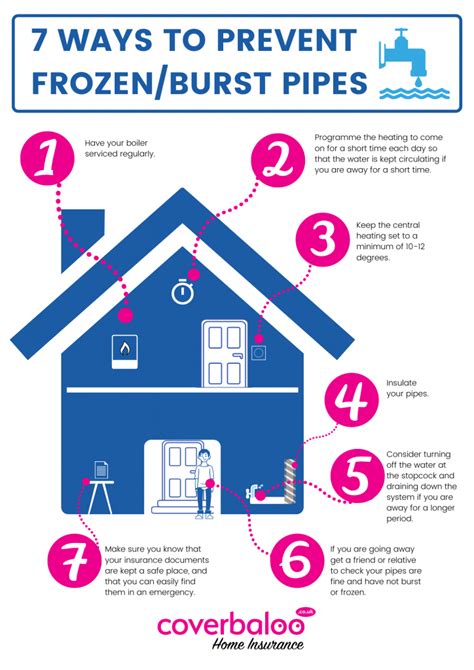Pipe Freeze Prevention: What You Need to Know
Frozen pipes are a homeowner's nightmare, leading to costly repairs, inconvenient disruptions, and potential water damage. Preventing frozen pipes requires proactive measures and understanding the factors that contribute to freezing. This comprehensive guide will equip you with the knowledge and strategies to protect your plumbing system from the damaging effects of winter's chill.
What Causes Pipes to Freeze?
Pipes freeze when the water inside them drops below 32°F (0°C). This is most likely to occur in areas exposed to cold temperatures, such as uninsulated exterior walls, attics, crawl spaces, and basements. Factors contributing to freezing include:
- Exposure to cold air: Uninsulated pipes located in cold areas are highly susceptible to freezing.
- Low water flow: Slowly moving or stagnant water freezes more easily than rapidly flowing water.
- Sudden temperature drops: A rapid decrease in temperature can catch pipes off guard before adequate preventative measures can be taken.
- Lack of insulation: Inadequate insulation around pipes allows heat to escape, increasing the risk of freezing.
How to Prevent Pipes From Freezing: Simple Steps for Protection
Preventing frozen pipes is largely about minimizing heat loss and ensuring adequate water flow. Here’s a breakdown of effective strategies:
1. Insulate Exposed Pipes:
This is the most crucial step. Use pipe insulation sleeves or foam rubber specifically designed for plumbing. These are readily available at most hardware stores and are easy to install. Focus on pipes located in unheated areas, such as those in crawl spaces, attics, or exterior walls.
2. Let the Faucets Drip:
Maintaining a slow drip from faucets, especially those on exterior walls, keeps a small amount of water flowing through the pipes. This flow prevents the water from becoming completely stagnant and freezing.
3. Open Cabinet Doors Under Sinks:
This allows warmer air from the room to circulate around the pipes located under sinks, particularly those on exterior walls. The added warmth can make a significant difference in preventing freezing.
4. Seal Gaps and Cracks:
Caulk any gaps or cracks around pipes that allow cold air to enter. This helps maintain a warmer temperature around the pipes. Pay particular attention to areas where pipes penetrate exterior walls.
5. Keep Your Thermostat Set to a Consistent Temperature:
Even when away from home, maintaining a consistently warmer temperature, even if just slightly above freezing, will help prevent freezing. Consider a programmable thermostat for optimal temperature control.
6. Protect Outdoor Faucets:
Install insulated faucet covers or disconnect outdoor hoses completely to prevent water from freezing inside the pipes leading to the spigot.
What to Do If Your Pipes Freeze
Despite your best efforts, pipes may still freeze. Here’s what to do:
- Locate the frozen pipe: Identify the section of pipe that's frozen. You’ll likely notice a lack of water flow or unusual noises.
- Turn off the water supply: Shut off the main water supply to prevent further damage if the pipe bursts.
- Apply heat gradually: Use a hairdryer, heat lamp, or space heater to slowly thaw the pipe. Avoid using an open flame. It is crucial to avoid sudden temperature changes, as this can cause the pipe to crack.
- Monitor for leaks: Once thawed, carefully check for any leaks.
- Call a plumber: If you're unsure or if the problem persists, contact a qualified plumber.
Frequently Asked Questions (PAAs)
What temperature does a pipe freeze?
Pipes typically freeze when the water temperature drops below 32°F (0°C). However, the exact temperature can vary depending on factors like water pressure and pipe material.
How long does it take for a pipe to freeze?
The time it takes for a pipe to freeze depends on several factors, including the ambient temperature, the amount of insulation around the pipe, and the water flow rate. It can range from a few hours to several days.
How can I prevent frozen pipes in a vacant house?
For vacant houses, maintaining a slightly warmer temperature, leaving a few faucets dripping, and thoroughly insulating exposed pipes are crucial. Consider asking a trusted neighbor to regularly check on the property and report any issues.
Can frozen pipes burst?
Yes, frozen pipes can burst due to the expansion of water as it freezes. This expansion can exert significant pressure on the pipe walls, causing them to crack or burst, leading to significant water damage. This is why prevention is so vital.
What is the best insulation for pipes?
Foam pipe insulation sleeves are a common and effective choice. They are readily available, easy to install, and provide good insulation.
By taking proactive steps to prevent frozen pipes, you can protect your home and your wallet from the costly consequences of frozen plumbing. Remember that prevention is far more cost-effective than repair.

